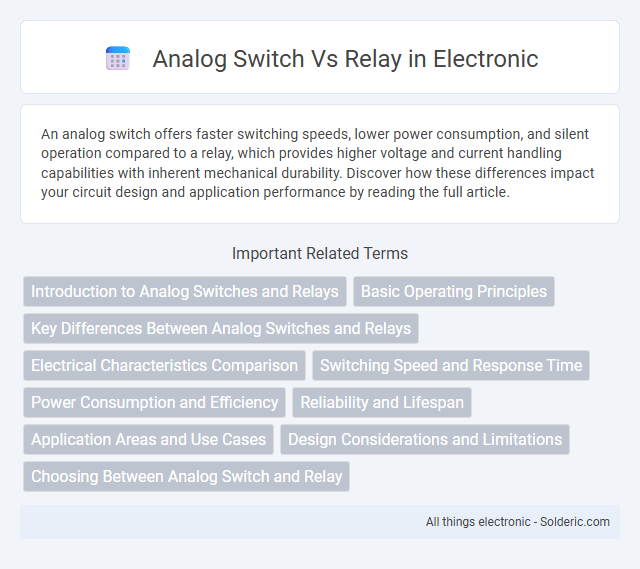An analog switch offers faster switching speeds, lower power consumption, and silent operation compared to a relay, which provides higher voltage and current handling capabilities with inherent mechanical durability. Discover how these differences impact your circuit design and application performance by reading the full article.
Comparison Table
| Feature | Analog Switch | Relay |
|---|---|---|
| Operation | Semiconductor based electronic switching | Electromechanical switching with coil and contacts |
| Switching Speed | Nanoseconds to microseconds | Milliseconds |
| Durability | High, no mechanical wear | Limited by mechanical contact wear |
| Size | Compact, integrated circuit | Bulkier due to mechanical parts |
| Power Consumption | Low, minimal current | High, continuous coil power required |
| Noise | Silent operation | Audible clicking sound |
| Voltage & Current Ratings | Typically low voltage/current (up to tens of volts) | Supports high voltage/current loads |
| Applications | Signal routing, audio switching, low-power circuits | High power switching, isolation, AC/DC switching |
Introduction to Analog Switches and Relays
Analog switches use semiconductor devices to control signal pathways with fast switching times and low power consumption, ideal for signal routing in electronic circuits. Relays operate mechanically using electromagnetic coils to open or close contacts, providing galvanic isolation and high voltage handling capacity suitable for switching heavy loads. Your choice depends on factors like switching speed, load requirements, and isolation needs, with analog switches better for low-power signal applications and relays preferred for high-power or high-voltage control.
Basic Operating Principles
An analog switch uses semiconductor components such as MOSFETs to control the flow of analog signals by opening or closing the circuit electronically, allowing for fast switching and low signal distortion. A relay operates mechanically with an electromagnetic coil that physically moves contacts to open or close the circuit, providing galvanic isolation and the ability to switch higher voltages and currents. Your choice depends on the requirement for speed, signal integrity, and isolation in the application.
Key Differences Between Analog Switches and Relays
Analog switches use semiconductor components to control signal paths with fast switching speeds and low power consumption, while relays rely on electromagnetic coils to physically open or close contacts, offering galvanic isolation and higher voltage tolerance. Analog switches provide compact size and silent operation, ideal for high-frequency or precision applications, whereas relays excel in switching higher currents and are more robust against electrical noise and surges. Your choice between the two depends on requirements like switching speed, load voltage, isolation needs, and form factor.
Electrical Characteristics Comparison
Analog switches offer low on-resistance and fast switching speeds, making them ideal for signal routing in low-voltage applications. In contrast, relays provide galvanic isolation and can handle higher voltages and currents but exhibit slower mechanical switching and contact bounce. Your choice depends on whether you prioritize precise signal integrity with analog switches or robust isolation and power handling with relays.
Switching Speed and Response Time
Analog switches offer significantly faster switching speeds, typically in the nanosecond to microsecond range, compared to electromechanical relays which operate in milliseconds. Their response time advantages make analog switches ideal for high-frequency signal routing and fast digital circuits. Relays exhibit slower response times due to mechanical movement, limiting their use in applications requiring rapid switching.
Power Consumption and Efficiency
Analog switches typically consume significantly less power than electromechanical relays, as they operate using semiconductor components without the need for coil activation. The low power consumption of analog switches enhances overall circuit efficiency, making them suitable for battery-powered and energy-sensitive applications. Relays, while robust and capable of handling higher currents, draw continuous power to maintain their energized state, leading to higher energy consumption.
Reliability and Lifespan
Analog switches offer higher reliability and longer lifespan compared to mechanical relays due to the absence of moving parts, reducing wear and mechanical failure. Relays are prone to contact degradation and mechanical fatigue, limiting their operational cycles to around 10^5 to 10^7 cycles. Solid-state analog switches can achieve up to 10^9 cycles, making them preferable for high-frequency switching applications requiring durability.
Application Areas and Use Cases
Analog switches are widely used in signal routing for audio and video equipment, data acquisition systems, and instrumentation due to their fast switching speed and low on-resistance. Relays are preferred in applications requiring higher voltage or current isolation, such as industrial automation, power control, and automotive systems, where mechanical durability and electrical isolation are critical. While analog switches excel in low-power electronic circuits, relays dominate in scenarios demanding robust switching under harsh environmental conditions.
Design Considerations and Limitations
Analog switches offer faster switching speeds, smaller size, and lower power consumption compared to relays, making them ideal for high-frequency and low-voltage applications. Relays provide galvanic isolation and can handle higher current and voltage ratings, but their mechanical nature leads to slower response times and limited lifecycle due to wear. Your choice should balance the need for isolation, switching speed, durability, and the specific electrical requirements of your design.
Choosing Between Analog Switch and Relay
Choosing between an analog switch and a relay depends on factors such as switching speed, signal integrity, and power handling. Analog switches offer faster switching times, lower contact resistance, and are suited for low-level signal applications, while relays provide galvanic isolation and can handle higher voltages and currents. Evaluating requirements like noise sensitivity, load type, and control voltage helps determine the optimal component for reliable circuit performance.
analog switch vs relay Infographic

 solderic.com
solderic.com